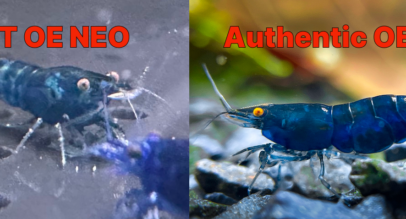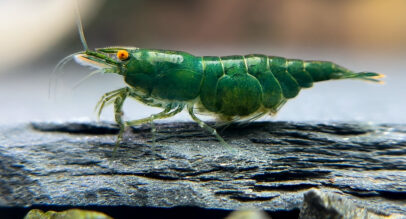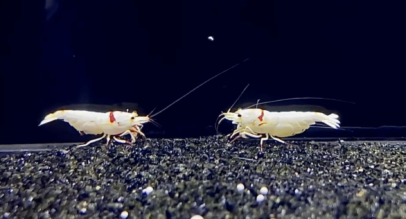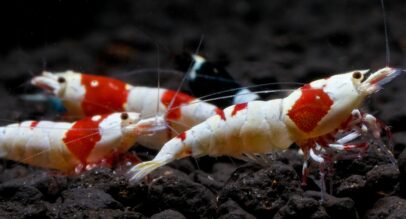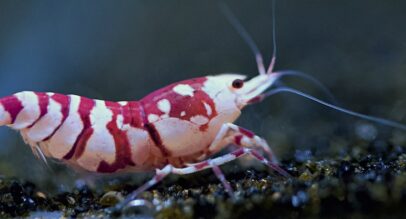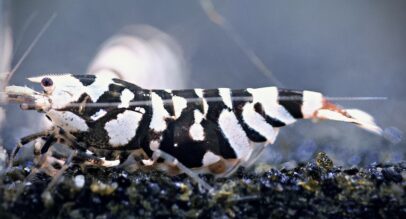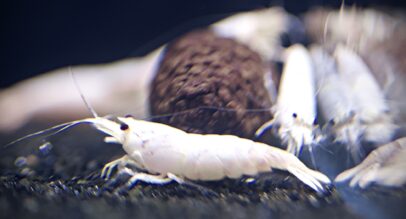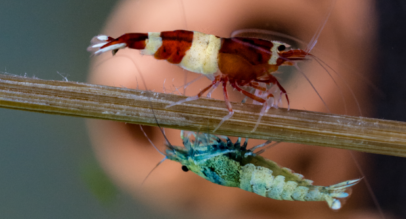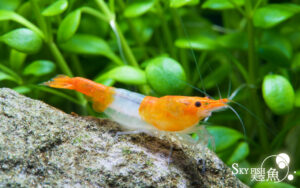 The foundation of a thriving Orange Rili shrimp colony lies in understanding their nutritional needs. While Neocaridina species are generally known for their adaptability and less demanding nature compared to their Caridina cousins, providing proper nutrition remains crucial for maintaining vibrant colors, supporting successful breeding, and ensuring long-term colony health.
The foundation of a thriving Orange Rili shrimp colony lies in understanding their nutritional needs. While Neocaridina species are generally known for their adaptability and less demanding nature compared to their Caridina cousins, providing proper nutrition remains crucial for maintaining vibrant colors, supporting successful breeding, and ensuring long-term colony health.
Think of feeding Orange Rili shrimp as a two-layer approach: you’re not just feeding the shrimp directly, but also supporting the tank’s ecosystem that provides supplementary nutrition. In the wild, these shrimp constantly graze on biofilm, algae, and microscopic organisms. Recreating this natural feeding pattern in our aquariums helps promote their natural behaviors and optimal health.
The relationship between nutrition and breeding success cannot be overstated. Female Orange Rili shrimp require additional protein and calcium during breeding periods to produce healthy eggs and maintain their shells through multiple breeding cycles. A well-fed colony will show higher breeding rates, better survival rates of juveniles, and more consistent breeding throughout the year rather than sporadic attempts.
Perhaps one of the most fascinating aspects of Orange Rili nutrition is its direct impact on coloration. The vibrant orange patterns these shrimp are prized for depend heavily on carotenoids and other pigments obtained through their diet. Without proper nutrition, you might notice your shrimp developing pale or washed-out colors over time. This is particularly important for maintaining a visually striking display colony and ensuring the desirable traits are passed on to future generations.
When it comes to longevity, proper nutrition plays a vital role in the immune system function of Orange Rili shrimp. Well-fed shrimp are more resistant to common stressors like minor water parameter fluctuations and have more energy reserves to handle the demands of molting. While Neocaridina shrimp typically live 1-2 years, optimal nutrition can help push their lifespan toward the upper end of this range and ensure they remain active and vibrant throughout their lives.
The key to success lies in understanding that Orange Rili shrimp thrive on variety – from high-quality commercial shrimp foods to blanched vegetables, and from powdered supplements to the natural biofilm in your tank. This diversity ensures they receive all necessary nutrients while maintaining their natural foraging behaviors that keep them active and engaged in their environment.
Core Feeding Philosophy for Orange Rili Shrimp
When it comes to feeding Orange Rili shrimp, embracing simplicity stands as a cornerstone principle. Think of your shrimp tank as a miniature ecosystem where every feeding decision creates ripples throughout the entire environment. Many newcomers to the hobby make the mistake of overcomplicating their feeding regimens, but understanding the elegant simplicity of shrimp nutrition can lead to better outcomes.
The connection between feeding and water stability forms the foundation of successful shrimp keeping. Every piece of food introduced to your aquarium ultimately becomes part of your water chemistry. When we feed too much or too frequently, we’re not just risking uneaten food – we’re potentially disrupting the delicate balance of parameters that Orange Rili shrimp need to thrive. Picture it like maintaining a balanced checkbook: inputs (feeding) must align with outputs (consumption and breakdown) to maintain stability.
Excess food breaks down into ammonia, triggering changes in nitrogen compounds that can stress your shrimp. This is why experienced keepers often say that underfeeding is far safer than overfeeding. Your shrimp can easily supplement their diet with naturally occurring biofilm and algae during leaner periods, but recovering from water quality issues caused by overfeeding can be challenging and potentially devastating to your colony.
Taking an ecosystem approach to nutrition means understanding that your tank is more than just water and shrimp – it’s a complex web of beneficial bacteria, microorganisms, and botanical elements that all contribute to shrimp nutrition. When you establish this ecosystem-focused mindset, you begin to see feeding as nurturing the entire system rather than just providing food for the shrimp.
This ecosystem approach has practical implications. For instance, allowing leaves and botanicals to naturally decompose in your tank provides not only direct nutrition but also surfaces for biofilm development. Similarly, encouraging controlled algae growth in well-lit areas creates natural grazing opportunities that mimic the shrimps’ natural feeding behaviors.
The maturity of your tank’s ecosystem plays a crucial role in this philosophy. A well-established tank (running for several months) develops robust colonies of beneficial bacteria and thick biofilm layers, reducing the need for frequent feeding. This is why shrimp often do better in mature tanks – the ecosystem provides a constant supply of natural food sources between planned feedings.
Understanding this core feeding philosophy helps create a sustainable environment where Orange Rili shrimp can not only survive but truly flourish. By maintaining simple feeding routines, monitoring water stability, and supporting the tank’s ecosystem, you create conditions that promote natural behaviors, successful breeding, and vibrant coloration without the need for complex feeding schedules or expensive specialized foods.
This approach also builds resilience into your system. When the ecosystem is healthy and stable, your shrimp colony becomes better equipped to handle minor fluctuations in feeding schedules or environmental conditions, much like how a diverse natural habitat helps protect wild populations from environmental stresses.
Essential Diet Components for Orange Rili Shrimp
Understanding the core components of an Orange Rili shrimp’s diet helps us provide optimal nutrition while maintaining water quality. Let’s explore each essential aspect of their dietary needs and how to meet them effectively.
Staple Food Requirements
The foundation of any Orange Rili diet begins with high-quality staple foods. These form the backbone of their nutrition, providing essential proteins, minerals, and vitamins necessary for growth, molting, and reproduction. The Rare Shrimp Complete food line offers an excellent base for this purpose, as it’s specifically formulated to meet these fundamental nutritional needs.
Draw Factor and Its Critical Role
Draw factor refers to how quickly shrimp are attracted to their food, which is particularly important in community tanks where other creatures might compete for resources. A proper draw factor ensures your shrimp find and consume their food before it can break down and affect water quality. Think of it like a dinner bell – when the attractants are right, you’ll see your shrimp gathering to feed within minutes of introduction.
The 2-3 Hour Rule: Food Stability
Food stability represents one of the most crucial aspects of shrimp nutrition. Any food remaining in your tank should maintain its structural integrity for 2-3 hours underwater. This timeframe allows shrimp to feed naturally while preventing rapid decomposition that could compromise water quality. The Rare Shrimp Complete foods excel in this regard, maintaining their form while slowly releasing nutrients.
Understanding Digestibility
Digestibility determines how efficiently your shrimp can extract nutrients from their food. Higher digestibility means less waste production and better nutrient absorption. For Orange Rili shrimp, we want foods that break down easily in their digestive system while remaining stable in water – seemingly contradictory requirements that quality foods like Rare Shrimp Complete have managed to balance effectively.
Nutritional Balance Requirements
A proper nutritional balance for Orange Rili shrimp includes:
- Proteins (30-40%) for growth and molting
- Plant matter for fiber and minerals
- Calcium for shell development
- Carotenoids for color enhancement
- Essential fatty acids for overall health
The Rare Shrimp Complete food line (available at https://www.amazon.com/dp/B0DJR3XX3J) has been formulated to provide this balance, making it an excellent choice for maintaining healthy colonies.
Proper Portions and Feeding Methods
Portion control is crucial for maintaining water quality and shrimp health. A good rule of thumb is to feed only what your shrimp can consume within those critical 2-3 hours. For a typical colony, this usually means a portion about the size of a pea for every 10-15 adult shrimp. However, you’ll need to adjust based on your tank’s specific conditions and population.
When feeding, consider these methods:
- Use feeding dishes to contain the food and make cleanup easier
- Distribute food in areas with good water flow to help attract shrimp
- Observe how quickly your colony consumes the food and adjust portions accordingly
- Feed at regular times to establish a routine and make monitoring easier
The beauty of using a complete food like the Rare Shrimp line is that it simplifies this process while ensuring your shrimp receives all the necessary nutrients. This removes much of the guesswork from feeding while maintaining the simplicity that makes Neocaridina species so appealing to keep.
Remember that these feeding guidelines should be adjusted based on your tank’s specific conditions. Factors like tank maturity, population density, and the presence of natural food sources (biofilm, algae) all influence how much supplementary feeding your colony requires.
Biofilm Development for Orange Rili Shrimp
Natural biofilm plays a fundamental role in the health and sustainability of Orange Rili shrimp colonies, serving as both a primary food source and a crucial component of their habitat. Understanding and promoting biofilm development creates a more natural environment that supports your shrimp’s instinctive behaviors and nutritional needs.
Natural Grazing Behavior
Orange Rili shrimp are constant grazers by nature, spending much of their time methodically searching for and consuming biofilm from various surfaces in their environment. This grazing behavior isn’t just about nutrition – it’s deeply ingrained in their biology and contributes to their overall well-being. When you watch your shrimp colony, you’ll notice them constantly moving across surfaces, their tiny appendages working to collect microscopic particles of food. This natural feeding pattern helps maintain healthy digestion and provides regular exercise, much like how grazing animals in the wild stay healthy through constant movement and feeding.
Importance for Colony Health
Biofilm serves as more than just a food source – it’s a complex microecosystem that provides various benefits for your shrimp colony. This living layer contains beneficial bacteria, microalgae, and other microorganisms that contribute to the shrimp’s immune system development, particularly in young shrimp. The constant availability of biofilm also helps stabilize the colony’s nutrition between regular feedings, acting as a natural buffer against periods of reduced feeding or stress.
Supporting Healthy Microorganism Growth
The development of healthy biofilm depends on creating the right conditions for beneficial microorganisms to thrive. Think of your tank as a tiny planet, where different microhabitats support various types of beneficial organisms. The key factors influencing microorganism growth include:
Water parameters must remain stable, as sudden changes can disrupt the delicate balance of microorganism communities. Proper lighting is essential, as it supports the growth of beneficial algae within the biofilm. Temperature stability also plays a crucial role, as microorganisms have optimal temperature ranges for growth and reproduction.
Methods for Promoting Biofilm
Developing robust biofilm requires a methodical approach. One highly effective method is using Rare Shrimp Biofilm Culture Bags (available at https://www.amazon.com/dp/B0DKN8C231), which provide an ideal substrate for biofilm development while releasing beneficial trace elements into the water. These specialized culture bags work by creating protected areas where beneficial microorganisms can establish themselves and multiply.
Beyond using dedicated products, you can promote biofilm development through several complementary methods:
Adding natural botanicals such as leaf litter creates additional surfaces for biofilm to develop while slowly releasing beneficial tannins. Positioning hardscape elements to create areas of varying flow allows different types of biofilm to develop, as some microorganisms prefer higher flow areas while others thrive in calmer waters. Maintaining consistent but not excessive lighting helps support photosynthetic organisms within the biofilm without promoting problematic algae growth.
The maturation process for biofilm takes time – typically several weeks to months for full development. During this period, it’s important to resist the urge to clean every surface in your tank. Some areas should be left undisturbed to allow biofilm communities to establish themselves fully.
Using Biofilm Culture Bags effectively involves strategic placement throughout your tank. Position them in areas with moderate water flow, which provides nutrients to the developing biofilm while preventing debris accumulation. The bags should be replaced periodically according to the manufacturer’s recommendations to maintain optimal effectiveness.
Understanding the cycle of biofilm development helps you make better maintenance decisions. While regular tank maintenance is important, it’s equally crucial to preserve established biofilm colonies. When cleaning, focus on removing debris while leaving some surfaces untouched, allowing the biofilm to maintain its beneficial presence in your shrimp ecosystem.
Professional Feeding Schedule for Orange Rili Shrimp
A well-structured feeding schedule forms the cornerstone of successful Orange Rili shrimp keeping. The alternating feeding approach I’ll describe creates an optimal balance between nutrition and ecosystem health while maintaining stable water parameters essential for long-term colony success.
The Daily Routine: Understanding the Alternating Pattern
The professional feeding schedule for Orange Rili shrimp follows an elegantly simple alternating pattern that mirrors natural feeding cycles. On one day, you’ll provide the Rare Shrimp Complete food (https://www.amazon.com/dp/B0DJR3XX3J), and on the next, you’ll dose with the Rare Shrimp Microbial supplement (https://www.amazon.com/dp/B0DKN7H9LF). This alternation serves multiple purposes that benefit both the shrimp and their environment.
Why This Schedule Works
Think of this feeding pattern as creating a perfect symphony between direct nutrition and ecosystem support. When you feed the Complete food, you’re providing immediate nutrition that the shrimp can consume directly. The following day, when you add the Microbial supplement, you’re supporting the tank’s microorganism population, which in turn creates additional natural food sources through enhanced biofilm development.
This alternating schedule prevents the common problem of nutrient accumulation that can occur with daily feeding of the same food. By spacing out the Complete food administration, you give your tank’s biological filtration system time to process the nutrients fully, maintaining better water quality over time.
Implementing the Schedule
For optimal results, maintain consistent timing for your feeding routine. Here’s how to execute this schedule effectively:
Day 1: Add a portion of Rare Shrimp Complete food appropriate for your colony size (remember the pea-sized portion per 10-15 adult shrimp rule we discussed earlier). Monitor consumption over the next 2-3 hours to fine-tune the portion size.
Day 2: Add the recommended dose of Rare Shrimp Microbial supplement. This supplement works throughout the day to enhance your tank’s microscopic ecosystem, supporting natural food production through improved biofilm development.
Understanding Timing and Portions
The timing of your daily feeding matters less than consistency. Choose a time when you can regularly observe your shrimp for at least the first few minutes after feeding. This observation period helps you adjust portions based on your colony’s response and ensures the food is being discovered and consumed properly.
When dosing the Microbial supplement, consistency in timing helps establish a stable pattern of microorganism growth and activity. This regularity supports a more robust ecosystem that better serves your shrimp colony’s nutritional needs.
Adjusting for Tank Conditions
While this schedule provides an excellent baseline, you should adjust it based on several factors:
Tank Maturity: Newer tanks might require slightly more frequent feeding of Complete food as the natural ecosystem is still developing. Mature tanks often need less supplemental feeding due to established biofilm.
Colony Size: Larger colonies might need slightly larger portions, but resist the urge to overfeed. It’s better to slightly underfeed and let natural foraging supplement their diet.
Breeding Activity: During heavy breeding periods, you might notice increased consumption. Pay attention to your colony’s behavior and adjust portions accordingly while maintaining the alternating schedule.
Observation Periods and Weekly Protocol for Orange Rili Shrimp
Understanding how to observe and respond to your shrimp colony’s behavior forms an essential part of successful shrimp keeping. Let’s explore the weekly feeding protocol and how to time your observations for optimal colony health.
Weekly Protocol Structure
The weekly feeding schedule creates a rhythm that supports both direct nutrition and ecosystem health through carefully timed supplementation. This protocol integrates regular feeding with specialized supplements to create a comprehensive nutritional approach.
The basic weekly schedule flows like this: Day 1: Regular feeding with Rare Shrimp Complete Food Day 3: Microbial supplement administration Day 5: Second regular feeding Day 7: Combined microbial supplement and vitamin administration
Understanding Supplementation Timing
The timing of supplements plays a crucial role in maintaining colony health. The Rare Shrimp Vitamins (https://www.amazon.com/dp/B0DKN58D6M) are specifically designed for immune system support and overall health enhancement. Adding these vitamins on Day 7 helps ensure your colony maintains strong disease resistance while supporting their natural metabolic processes.
Think of the weekly protocol as building layers of protection and nutrition. The regular feedings provide the foundational nutrition, while the microbial supplement supports the ecosystem, and the vitamins add an extra layer of immune support. This layered approach creates a more resilient colony that can better handle environmental stresses.
Observation Techniques and Timing
The most valuable observations occur during the first 30 minutes after adding food or supplements. During this period, pay attention to several key behaviors:
Initial Response Time: Healthy shrimp should respond to food within minutes of introduction. If you notice delayed responses, this might indicate issues with water parameters or the draw factor of your food.
Feeding Patterns: Watch how your shrimp interact with the food. Strong feeding behavior indicates good colony health, while disinterest might suggest problems that need addressing.
Group Dynamics: Observe how different sizes of shrimp access the food. Healthy colonies show a mix of ages feeding together without excessive competition.
Biofilm Development Monitoring
The Rare Shrimp Biofilm Culture Bags (https://www.amazon.com/dp/B0DKN8C231) require their observation protocol. When you first introduce these bags, watch for:
Initial Colonization: Within the first week, you should see a slight change in the surface appearance of the bags as beneficial bacteria begin to establish themselves.
Shrimp Interest: Healthy biofilm development will naturally attract shrimp to graze on the bags. This behavior should increase over time as the biofilm matures.
Color Changes: The biofilm will develop subtle color variations as different types of beneficial organisms establish themselves. This is normal and indicates a healthy ecosystem development.
Weekly Assessment Points
Make these specific observations part of your weekly routine:
Before Regular Feedings: Observe general colony activity and any grazing behavior on the biofilm bags. This gives you a baseline for colony behavior.
During Supplement Addition: Watch how quickly the colony responds to the microbial supplement. You should see increased activity around areas where the supplement settles.
Vitamin Day Observations: On Day 7, when adding both microbial supplement and vitamins, pay special attention to molting activity in the following 24-48 hours, as proper vitamin supplementation often corresponds with successful molting cycles.
Common Pitfalls and Keys to Success with Orange Rili Shrimp
Understanding and avoiding common mistakes in shrimp keeping can mean the difference between a struggling colony and a thriving one. Let’s explore these critical aspects while focusing on how to achieve long-term success with your Orange Rili shrimp.
Understanding the Risks of Overfeeding
Overfeeding represents one of the most significant threats to shrimp colony health, yet it’s also one of the most common mistakes new keepers make. When we add too much food to our tanks, we’re not just wasting resources – we’re actively creating potential problems. Excess food breaks down into ammonia, which can quickly overwhelm your tank’s biological filtration system. This process often creates a cascade effect: ammonia spikes lead to nitrite increases, which then cause nitrate accumulation. Your shrimp can handle modest nitrate levels, but rapid changes in these parameters can cause severe stress.
The Truth About Supplements
Supplements can be powerful tools for maintaining shrimp health, but they must be used thoughtfully and in the right context. Think of supplements like vitamins for humans – they support health but can’t replace proper nutrition or living conditions. The Rare Shrimp Vitamins are designed to enhance an already healthy system, not fix fundamental problems in an unstable tank.
A crucial point that cannot be overstated: supplements should never be viewed as a solution for an uncycled or unhealthy tank. Adding vitamins or other supplements to an unstable system is like trying to treat a fever while sitting in a sauna – you’re not addressing the root cause and might make things worse. Wait until your tank is fully cycled and showing consistent parameters before introducing any supplements.
Understanding Parameter Fluctuations
Parameter stability matters more than achieving “perfect” numbers. Your Orange Rili shrimp can adapt to slightly different conditions, but they struggle with sudden changes. When feeding and supplementing, monitor how these additions affect your water parameters. Even small fluctuations in pH, TDS, or other parameters can signal the need to adjust your feeding routine.
Recognizing Colony Stress Signals
Your shrimp will tell you when something’s wrong if you know what to look for. Common stress signals include:
- Lethargy or hiding behavior
- Reduced feeding response
- Irregular molting patterns
- Color fading
- Unexpected deaths
These signs often appear before major problems develop, giving you time to adjust your approach if you’re paying attention.
The Path to Long-Term Success
Success with Orange Rili shrimp comes from understanding that stability is the foundation of everything else. This means maintaining consistent feeding schedules, regular water parameters, and steady environmental conditions. Small, consistent actions have a much more positive impact than dramatic interventions.
Observation plays a crucial role in long-term success. Spend time watching your colony’s behavior, especially after feeding or adding supplements. Learn their normal patterns so you can quickly spot when something seems off. This observational knowledge becomes invaluable for making informed decisions about feeding and care.
Indicators of long-term success extend beyond just survival. A truly thriving colony shows:
- Regular breeding activity
- Successful molting across all age groups
- Active foraging behavior even between feedings
- Stable or growing population numbers
- Consistent coloration
- Even the distribution of sizes indicating successful juvenile development
Remember that success with Orange Rili shrimp isn’t about achieving perfection – it’s about creating and maintaining a stable environment where they can thrive naturally. Focus on the fundamentals: proper cycling, consistent maintenance, appropriate feeding, and careful observation. Everything else builds upon these essential elements.

